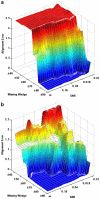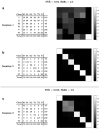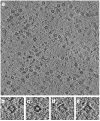Classification and 3D averaging with missing wedge correction in biological electron tomography
- PMID: 18440828
- PMCID: PMC2556382
- DOI: 10.1016/j.jsb.2008.02.008
Classification and 3D averaging with missing wedge correction in biological electron tomography
Abstract
Strategies for the determination of 3D structures of biological macromolecules using electron crystallography and single-particle electron microscopy utilize powerful tools for the averaging of information obtained from 2D projection images of structurally homogeneous specimens. In contrast, electron tomographic approaches have often been used to study the 3D structures of heterogeneous, one-of-a-kind objects such as whole cells where image-averaging strategies are not applicable. Complex entities such as cells and viruses, nevertheless, contain multiple copies of numerous macromolecules that can individually be subjected to 3D averaging. Here we present a complete framework for alignment, classification, and averaging of volumes derived by electron tomography that is computationally efficient and effectively accounts for the missing wedge that is inherent to limited-angle electron tomography. Modeling the missing data as a multiplying mask in reciprocal space we show that the effect of the missing wedge can be accounted for seamlessly in all alignment and classification operations. We solve the alignment problem using the convolution theorem in harmonic analysis, thus eliminating the need for approaches that require exhaustive angular search, and adopt an iterative approach to alignment and classification that does not require the use of external references. We demonstrate that our method can be successfully applied for 3D classification and averaging of phantom volumes as well as experimentally obtained tomograms of GroEL where the outcomes of the analysis can be quantitatively compared against the expected results.
Figures










References
-
- Bartesaghi A, Sprechmann P, Randall G, Sapiro G, Subramaniam S. Classification and averaging of electron tomography volumes; 4th IEEE International Symposium on Biomedical Imaging: From Nano to Macro; Washington, DC, USA. 2007.pp. 244–247.
-
- Crowther RA. In: The Molecular Replacement Method. Rossmann MG, editor. Gordon & Breach; New York: 1972. pp. 173–178.
-
- Förster F, Pruggnaller S, Seybert A, Frangakis AS. Classification of cryo-electron sub-tomograms using constrained correlation. Journal of Structural Biology. 2008;161(3):276–286. - PubMed
Publication types
MeSH terms
Substances
Grants and funding
LinkOut - more resources
Full Text Sources
Other Literature Sources
Research Materials

